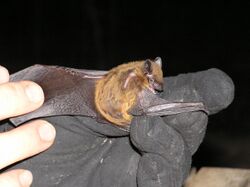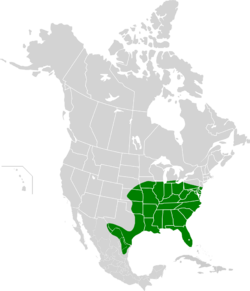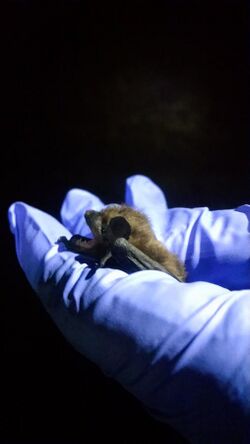Biology:Evening bat
| Evening bat | |
|---|---|

| |
| Scientific classification | |
| Domain: | Eukaryota |
| Kingdom: | Animalia |
| Phylum: | Chordata |
| Class: | Mammalia |
| Order: | Chiroptera |
| Family: | Vespertilionidae |
| Genus: | Nycticeius |
| Species: | N. humeralis
|
| Binomial name | |
| Nycticeius humeralis (Rafinesque, 1818)
| |

| |
The evening bat (Nycticeius humeralis) is a species of bat in the vesper bat family that is native to North America.[2] Hunting at night, they eat beetles, moths, and other flying insects.
Description
The evening bat is a small bat weighing 7–15 g (0.25–0.53 oz)[3] found throughout much of the midwestern and eastern United States . Their forearms are 34–38 mm (1.3–1.5 in) in length.[4] The tip of each dorsal hair is a light gray, and one to two-thirds of the basal is dark brown. Though there have been some cases of white pelage, the majority of the population is mostly brown in color.[4] They have wide, dog-like muzzles, pronounced facial glands, and disproportionately large bacula.[4][5] Evening bats can be mistaken for juvenile big brown bats, due to their physical resemblance but smaller size.
Morphology
Evening bats have relatively robust jaws, compared to other insectivorous bats.[6] They have an unkeeled calcar and a short, round tragus.[7] The curvature of the tragus helps distinguish it from bats of the genus Myotis, which otherwise look very similar.[7] Their skull has one upper incisor on each side with 4 molariform teeth.[8]
Biology
The evening bat is a relatively short-lived, especially compared to other bats in its geographic range.[9] It has a maximum age of 6 years, though few individuals live past 4 years.[10][9] Its short lifespan for a bat could be explained by its considerably higher reproductive output. Bats that only have one pup per year would need to live much longer to have the same fitness as a shorter-lived species with two or three pups per year.[9]
Reproduction
Evening bats mate in the fall and winter; the sperm is stored until the spring, when fertilization occurs.[11] Female bats form maternity colonies in May,[12] consisting of 15-300 individuals.[3] Of females that give birth, 90% have twins, but singletons and triplets are also possible.[11][12][13] Though it is more common for evening bats to nurse their own offspring,[3] a small proportion of offspring are nursed by unrelated females. The pups are capable of flight within a month of birth.[12] Pups are weaned within 42 days of birth.[3] Female pups exhibit natal philopatry, meaning that as adults, they return to the roost where they were born to give birth.[3]
Diet
These bats have varied diets. A majority of the bats' diet in Indiana and Illinois are beetles, including the spotted cucumber beetle, which is a serious agricultural pest.[14] In southern Illinois, the spotted cucumber beetle is almost 25% of the evening bats' diet.[15] Other beetles consumed include ground beetles and scarab beetles.[14] Moths are also a significant dietary component.[14] Bugs, winged ants, and flies are prey items of less significance.[15][16] Evening bats partition resources with other insectivorous bats in their range, such as the eastern red bat and Seminole bat.[16] Despite foraging in the same areas at the same time, these three bat species choose different prey items at different points throughout the summer.[16]
Distribution
At first, the evening bat was thought of as a southeastern bat species.[17] However, breeding evening bats have been found as far north as Michigan and as far west as the 100th meridian.[13] Evening bats roost in a variety of structures, including Spanish moss, under bark, in tree cavities, and in buildings.[18] For foraging habitat, evening bats in Georgia prefer pine forest, riparian zones, and open fields.[19] Evening bats have home ranges of approximately 300 hectare (1.15 mi2).[19] Because the evening bat is not found in the northernmost extent of its range in the winter, it is likely that at least some evening bats are migratory.[4]
Conservation
While the evening bat is considered endangered in the state of Indiana,[20] it has a cosmopolitan distribution throughout the southeast and midwest.[18] Because evening bats do not enter or hibernate in caves, the species is not at-risk from white-nose syndrome, which has killed over six million bats in the United States since 2006.[21] The evening bat's avoidance of this disease, along with die-offs of many other species, is possibly responsible for the evening bat recently expanding its range into Wisconsin in 2015 and Minnesota in 2016.[21][22]
| State | Conservation Status |
|---|---|
| Alabama | Lowest Conservation Concern |
| Arkansas | Not listed |
| Florida | Not listed |
| Georgia | Not listed |
| Illinois | Not listed |
| Indiana | State Endangered |
| Iowa | Not listed |
| Kentucky | Threatened |
| Kansas | Not listed |
| Louisiana | Not listed |
| Maryland | Not listed |
| Michigan | Threatened |
| Minnesota | Not listed |
| Mississippi | Not listed |
| Missouri | Not listed |
| Nebraska | Not listed |
| North Carolina | Not listed |
| Ohio | Species of Special Interest |
| Oklahoma | Not listed |
| Pennsylvania | Not listed |
| South Carolina | Not listed |
| Tennessee | Not listed |
| Texas | Not listed |
| Virginia | Not listed |
| West Virginia | Not listed |
| Wisconsin | Not listed |
References
- ↑ Solari, S. (2019). "Nycticeius humeralis". IUCN Red List of Threatened Species 2019: e.T14944A22015223. doi:10.2305/IUCN.UK.2019-1.RLTS.T14944A22015223.en. https://www.iucnredlist.org/species/14944/22015223. Retrieved 19 November 2021.
- ↑ Simmons, N.B. (2005). "Order Chiroptera". in Wilson, D.E.; Reeder, D.M. Mammal Species of the World: A Taxonomic and Geographic Reference (3rd ed.). Johns Hopkins University Press. pp. 312–529. ISBN 978-0-8018-8221-0. OCLC 62265494. http://www.departments.bucknell.edu/biology/resources/msw3/browse.asp?id=13801926.
- ↑ 3.0 3.1 3.2 3.3 3.4 Wilkinson, G.S. (1992). "Communal Nursing in the Evening Bat, Nycticeius humeralis". Behavioral Ecology and Sociobiology 31 (4): 225–235. doi:10.1007/bf00171677.
- ↑ 4.0 4.1 4.2 4.3 Watkins, L. C. (1972). Nycticeius humeralis. Mammalian species, (23), 1-4.
- ↑ Hamilton, W. J. (1949). "The bacula of some North American vespertilionid bats". Journal of Mammalogy 30 (2): 97–102. doi:10.2307/1375254. PMID 18121317.
- ↑ Freeman, P. W. (1981). "Correspondence of food habits and morphology in insectivorous bats". Journal of Mammalogy 62 (1): 166–173. doi:10.2307/1380489. http://digitalcommons.unl.edu/cgi/viewcontent.cgi?article=1016&context=museummammalogy.
- ↑ 7.0 7.1 Barbour, R., W. Davis. 1974. Mammals of Kentucky. Kentucky: The University Press of Kentucky.
- ↑ Whitaker, John O. (2010). Mammals of Indiana. Bloomington, IA: Indiana University Press. pp. 118 & 119. ISBN 978-0-253-22213-8.
- ↑ 9.0 9.1 9.2 Austad, S. N. (2010). Cats,"rats," and bats: the comparative biology of aging in the 21st century. Integrative and comparative biology, icq131.
- ↑ Humphrey, S. R.; Cope, J. B. (1970). "Population samples of the evening bat, Nycticeius humeralis". Journal of Mammalogy 51 (2): 399–401. doi:10.2307/1378503.
- ↑ 11.0 11.1 Whitaker, J. O., Jr., J. B. Cope, D. W. Sparks, V. Brack, Jr., and S. Johnson. Bats of Indiana. Publication no. 1, ISU Center for North American Bat Research and Conservation. Indiana State University. 59 pp.
- ↑ 12.0 12.1 12.2 Watkins, L. C., & Shump Jr, K. A. (1981). Behavior of the evening bat Nycticeius humeralis at a nursery roost. American Midland Naturalist, 258-268.
- ↑ 13.0 13.1 Kurta, A., Foster, R., Hough, E., & Winhold, L. (2005). The evening bat (Nycticeius humeralis) on the northern edge of its range—a maternity colony in Michigan. The American midland naturalist, 154(1), 264-267.
- ↑ 14.0 14.1 14.2 Whitaker Jr, J. O., & Clem, P. (1992). Food of the evening bat Nycticeius humeralis from Indiana. American Midland Naturalist, 211-214.
- ↑ 15.0 15.1 Feldhamer, G. A., Whitaker Jr, J. O., Krejca, J. K., & Taylor, S. J. (1995). Food of the evening bat (Nycticeius humeralis) and red bat (Lasiurus borealis) from southern Illinois. Transactions of the Illinois Academy of Science, 88, 139-143.
- ↑ 16.0 16.1 16.2 Carter, T. C., Menzel, M. A., Chapman, B. R., & Miller, K. V. (2004). Partitioning of food resources by syntopic eastern red (Lasiurus borealis), Seminole (L. seminolus) and evening (Nycticeius humeralis) bats. The American midland naturalist, 151(1), 186-191.
- ↑ Baker, W. W.; Marshall, S. G.; Baker, V. B. (1968). "Autumn fat deposition in the evening bat (Nycticeius humeralis)". Journal of Mammalogy 49 (2): 314–317. doi:10.2307/1377991.
- ↑ 18.0 18.1 Menzel, M. A., Carter, T. C., Ford, W. M., & Chapman, B. R. (2001). Tree-roost characteristics of subadult and female adult evening bats (Nycticeius humeralis) in the Upper Coastal Plain of South Carolina. The American Midland Naturalist, 145(1), 112-119.
- ↑ 19.0 19.1 Morris, A. D.; Miller, D. A.; Conner, L. M. (2011). "Home-range size of evening bats (Nycticeius humeralis) in southwestern Georgia". Southeastern Naturalist 10 (1): 85–94. doi:10.1656/058.010.0107.
- ↑ "Bats in Indiana". IN.gov. https://secure.in.gov/dnr/fishwild/8450.htm.
- ↑ 21.0 21.1 Bergquist, Lee (September 13, 2016). "First find of bat species in 60 years". Journal Sentinel (Milwaukee). http://www.jsonline.com/story/news/local/wisconsin/2016/09/13/first-find-bat-species-60-years/90328140/.
- ↑ "First new bat species discovered in Minnesota in more than a century". Minnesota DNR (Minnesota). August 1, 2016. http://news.dnr.state.mn.us/2016/08/01/first-new-bat-species-discovered-in-minnesota-in-more-than-a-century/.
External links
Wikidata ☰ Q1832323 entry
 |



